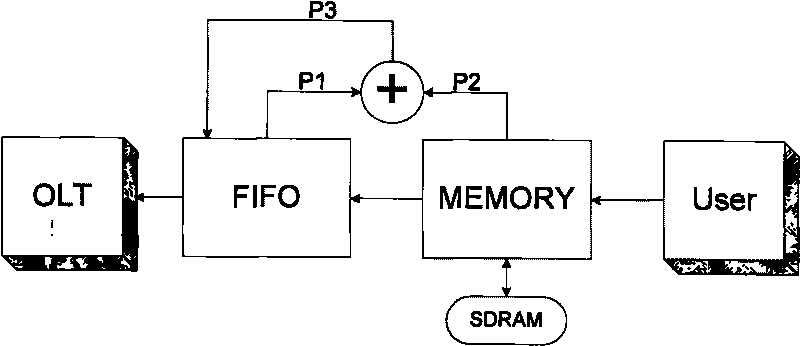Data scheduling method used in EPON terminal system and based on absolute priority
An absolute priority, terminal system technology, applied in the multiplexing system selection device, transmission system, digital transmission system and other directions, can solve the problems of starvation, inability to access external memory, bandwidth waste, etc., to achieve excellent results, satisfying Data transmission requirements, the effect of high bandwidth utilization
- Summary
- Abstract
- Description
- Claims
- Application Information
AI Technical Summary
Problems solved by technology
Method used
Image
Examples
Embodiment Construction
[0026] The present invention will be described in detail below in conjunction with accompanying drawing: EPON terminal system described in the present invention is a kind of point-to-multipoint network system, and it mainly comprises three parts: central office OLT, terminal ONU and passive optical branch device, the data scheduling method mainly includes the following parts:
[0027] aIn the ONU, add FIFOs for data caching: the number of FIFOs depends on the number of priorities that currently distinguish data. If the current data is divided into 8 priorities, the number of FIFOs is 8; if only If there are 4 priorities, the number of FIFOs is 4; the width of the FIFO generally matches the data width of the external memory. If the external memory has a data width of 32 bits, the data width of the FIFO is 32; the width of the FIFO optional depth;
[0028] b Allocate address space in the external memory according to the priority, simplify the scheduling algorithm: if the extern...
PUM
 Login to View More
Login to View More Abstract
Description
Claims
Application Information
 Login to View More
Login to View More - R&D
- Intellectual Property
- Life Sciences
- Materials
- Tech Scout
- Unparalleled Data Quality
- Higher Quality Content
- 60% Fewer Hallucinations
Browse by: Latest US Patents, China's latest patents, Technical Efficacy Thesaurus, Application Domain, Technology Topic, Popular Technical Reports.
© 2025 PatSnap. All rights reserved.Legal|Privacy policy|Modern Slavery Act Transparency Statement|Sitemap|About US| Contact US: help@patsnap.com



